La Vuelta 2021 - Stage 20: Sanxenxo > Mos. Castro de Herville 202,2 km **Spoilers**

blazing_saddles
Posts: 22,730
in Pro race
Stage 20: Sanxenxo > Mos. Castro de Herville 202,2 km
04-09-2021Start time: 10-47am
Stage 20 is untypical of the Vuelta, by not being a mountain stage. It's been promoted as a "mini Liège-Bastogne-Liège”, with around 3,000 metres of vertical gain in its second half, which is based on Mos, the hometown of 2006 Tour de France champion Oscar Pereiro, who’s the Vuelta’s ambassador and has designed this stage. The 202.2 kilometres race features roughly ten climbs with the toughest ones in the second half of the route and a short summit finish.
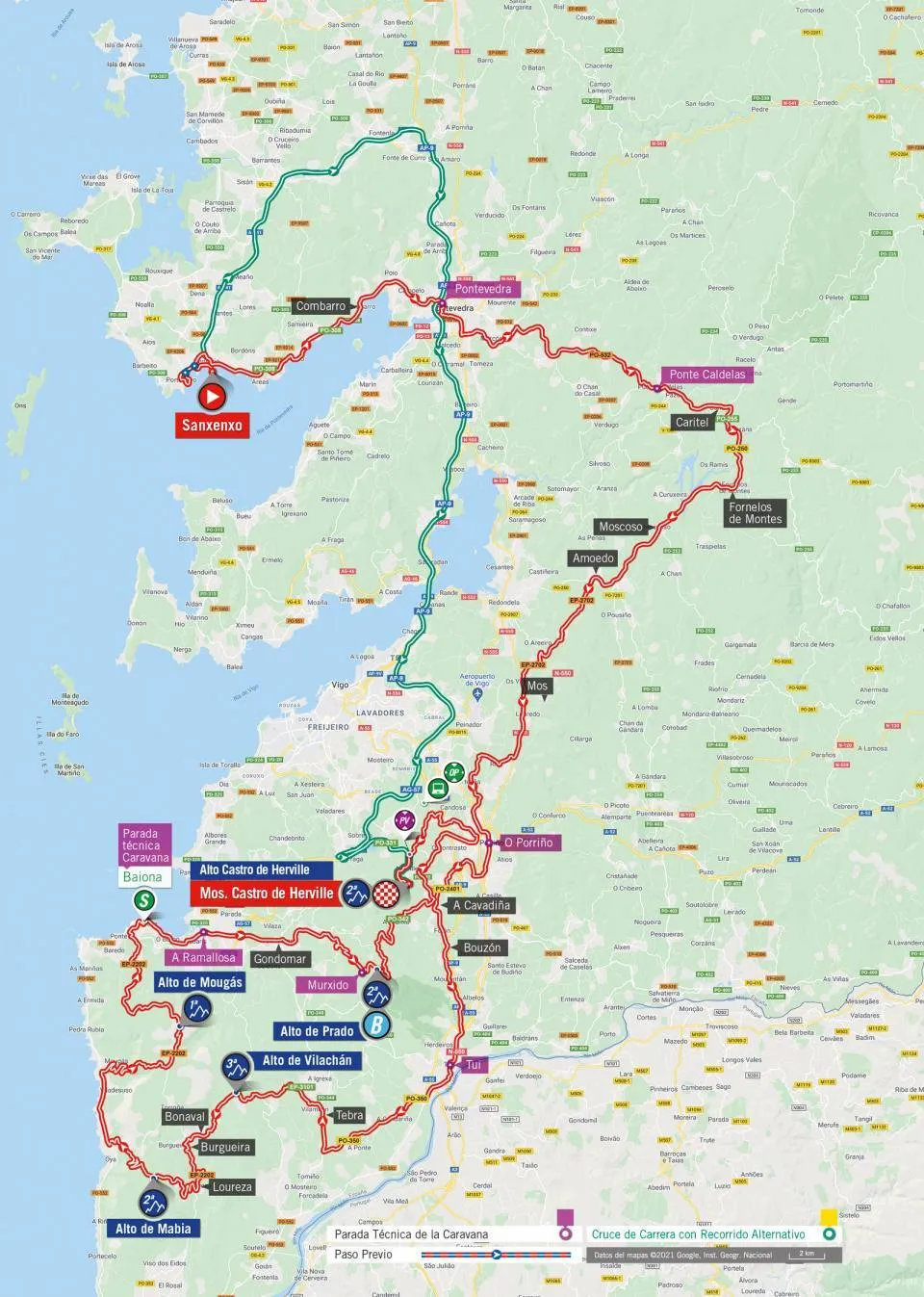
The climbs in the first 100 kilometres are not trying enough to receive a KOM classification, but, they will add to the fatigue. Pereiro describes his first ever stage design as being “rompe pernas” – which is Galician for leg-breaking. Also "perfect for ambushes".
From the start in Sanxenxo, the route undulates from the start. The route relentlessly rolls on and on, to its final test, above Mos.

Certainly, stage 20 at La Vuelta bears resemblance to Liège-Bastogne-Liège, although a comparison to the Tour of Lombardy is also in order.
The Climbs:
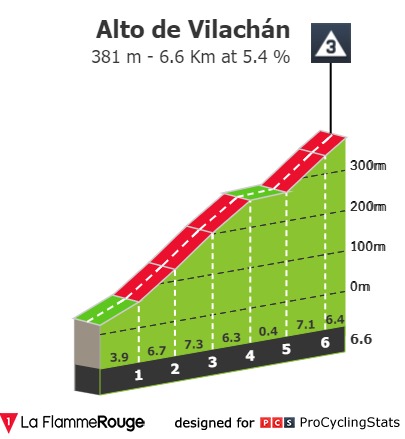
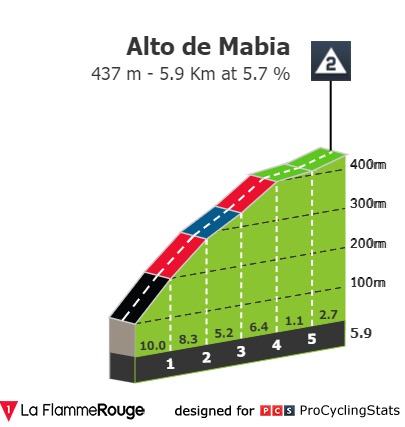
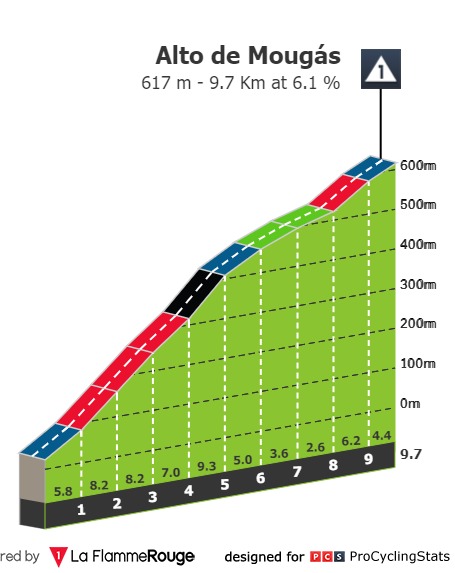
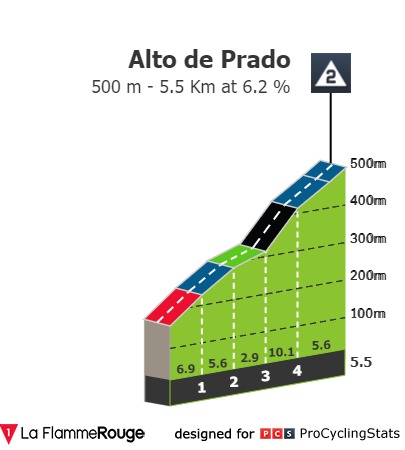
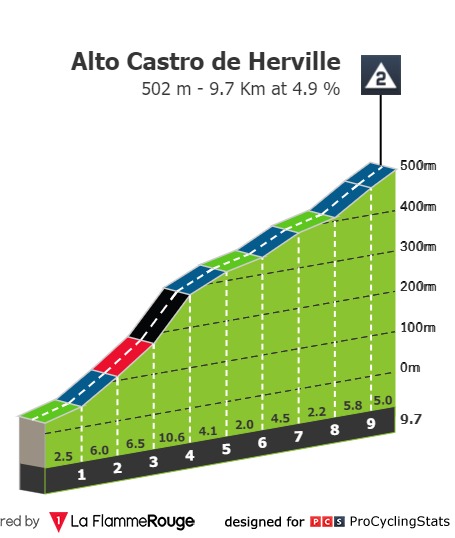
The finish climb adds up to 9.7 kilometres. Kilometre 4, for instance, climbs at double digits and moments later the route goes down again. And the last few hundred meters rise at almost 10% to the line.

No long ascents, but the type of climbs we'll see in the hilly classics. The second part of the race is particularly brutal, so expect the hilly specialists to fight for the stage honours and simultaneously a battle for the red jersey.
Favourites 20th stage 2021 Vuelta a España
*** Wout Poels, Ion Izagirre, Michael Storer, Romain Bardet
** Geoffrey Bouchard, Felix Großschartner, Pavel Sivakov, David de la Cruz, Tom Pidcock
* Damiano Caruso, Koen Bouwman, Thymen Arensman, Jesús Herrada, Lawson Craddock
Sanxenxo
Unprecedented departure
17.414 inhabitants
Province of Pontevedra.
The Pontevedra municipality, one of Galicia’s most popular holiday destinations, has an enviable climate and an average temperature of 15ºC all year round. It also has over 30 km of coastline that will surround the peloton’s route in what is to be Sanxenxo’s first stage departure in the history of La Vuelta.
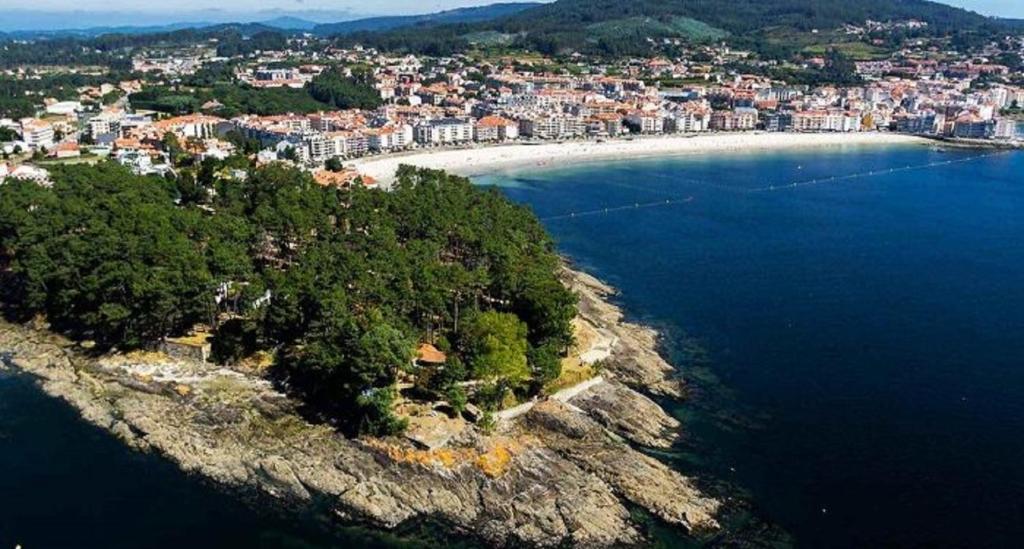
Polbo á feira
Polbo á feira (a.k.a. pulpo a la gallega) is a traditional Galician dish made by cooking octopus, potatoes, and sweet paprika powder in copper cauldrons. The cauldrons impart a unique flavor to the dish, and it is said that it is impossible to obtain that kind of flavor with any other material.

Mariscada gallega
Seafood dishes are one of the most typical dishes of traditional Galician cuisine . It is a dish made up of varied seafood: clams, oysters, crabs, crayfish, lobsters, prawns, barnacles and even crabs.
Due to the above, it is considered that the Galician seafood is a very complete, healthy and relatively simple dish to prepare.
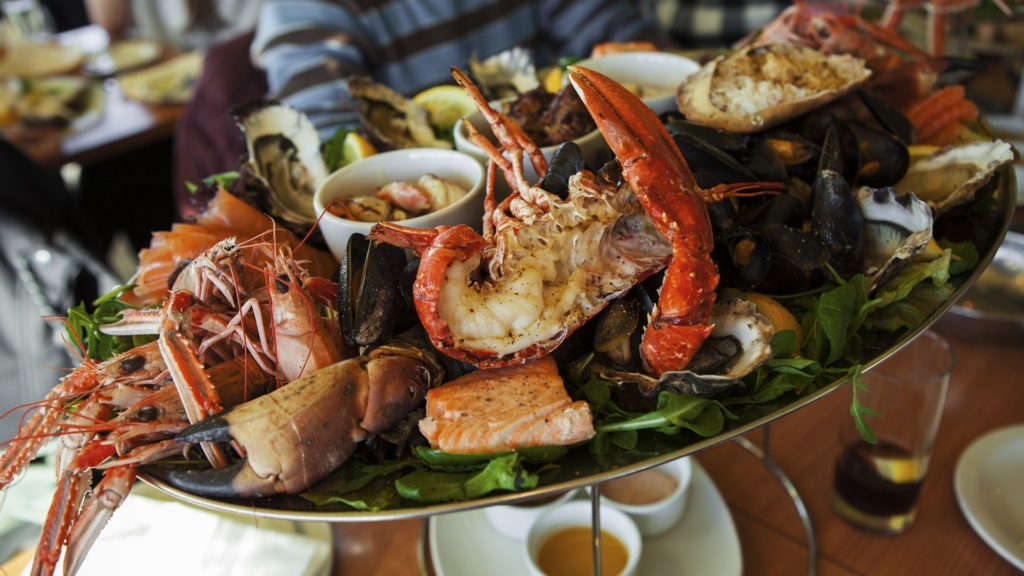
Mos. Castro de Herville
Unprecedented Vuelta finale
15.063 inhabitants
Province of Pontevedra
In 2020, Mos made its La Vuelta debut by hosting the start of an extremely tough stage headed to the Zamora locality of Puebla de Sanabria. This year, it will host the finish-line of a stage held entirely within the Province of Pontevedra. Despite never having hosted a La Vuelta stage arrival before, the locality is no stranger to being a finish-line: the municipality is one of the regular stops along the Portuguese Way of St. James. Óscar Pereiro, winner of the Tour de France in 2006 and a global Ambassador for La Vuelta and Mos, his birthplace, is one of the seven Spanish riders to have won a ‘Grande Boucle’.

The Louro River floods through Mos from north to south, making the municipality a valley region.
Mos is a transit point along the Portuguese version of The Way of St. James, the stop just before Pontevedra. After Mos, you head North, towards the Santiago Cathedral, where the pilgrimage comes to an end, as does this year's Vuelta.
Merluza (Hake)
Perhaps the most popular fish in Northern Spain, hake (or merluza in Spanish) can be found all over Galicia. The most traditional dish is merluza a la gallega. This is simply hake boiled with potatoes and served in a sauce made from garlic and pepper.

Structure of the day.
Hórreos
In the North of the Iberian Peninsula, a type of building typical for that region is the hórreos. A hórreo is granary built on pillars which lift it above the ground to protect the stored grain and produce from water seepage. The pillars are topped by the so-called ‘staddle stones’ which prevent the access of rats and vermin. The oldest hórreos still in existence date from the 15th century. There are about 18,000 hórreos and paneras (hórreos with more than four pillars) in Asturias. There are several different types of hórreo, which vary according to the materials used for the pillars and decoration and the characteristics of the roof (thatched, tiled, slate, pitched or double pitched). Hórreos can be built in stone or made from wood and slits in the side walls allow ventilation.

"Science is a tool for cheaters". An anonymous French PE teacher.
2
Comments
-
All in for the podium places"If I was a 38 year old man, I definitely wouldn't be riding a bright yellow bike with Hello Kitty disc wheels, put it that way. What we're witnessing here is the world's most high profile mid-life crisis" Afx237vi Mon Jul 20, 2009 2:43 pm0
-
Had a very wet trip to that part of Spain before I was mature enough to appreciate good food. Not keen on unrecognisable bits of minced mammal nowadays, but those seafood dishes look lovely.
Thanks to Blazing and others for the threadstarters and contributions.0 -
Wow, still all quiet here.
16 riders have over 9 minutes on the bunch, with both Storer and Bardet among them.
So it looks as if another hat trick could be on the cards."Science is a tool for cheaters". An anonymous French PE teacher.0 -
Presumably you mean Storer – but acc to interviews they had, both Bardet's and Storer's goal is to keep Storer in the mountain jersey, and if poss for Bardet to take the stage.blazing_saddles said:Wow, still all quiet here.
16 riders have over 9 minutes on the bunch, with both Storer and Bardet among them.
So it looks as if another hat trick could be on the cards.
Although, from the management POV, since Storer is leaving, DSM would probably prefer to have the jersey on Bardet.
There are several others in the break who could take the stage, though, like one of the 3 Spaniards (esp Navarro), Hirt, Champoussin, Calmejane.0 -
Ineos clearly not content to go down without a fight.
Starting to look as if the break is doomed."Science is a tool for cheaters". An anonymous French PE teacher.0 -
Bardet may not be well.jimmyjams said:
Presumably you mean Storer – but acc to interviews they had, both Bardet's and Storer's goal is to keep Storer in the mountain jersey, and if poss for Bardet to take the stage.blazing_saddles said:Wow, still all quiet here.
16 riders have over 9 minutes on the bunch, with both Storer and Bardet among them.
So it looks as if another hat trick could be on the cards.
Although, from the management POV, since Storer is leaving, DSM would probably prefer to have the jersey on Bardet.
There are several others in the break who could take the stage, though, like one of the 3 Spaniards (esp Navarro), Hirt, Champoussin, Calmejane.
Been to the doctor
"Science is a tool for cheaters". An anonymous French PE teacher.0 -
Pidcock slowly destroying the peloton"Science is a tool for cheaters". An anonymous French PE teacher.0
-
Which is annoying when you pick him for PTP hoping to see him ride like that in the break.blazing_saddles said:Pidcock slowly destroying the peloton
I also picked Trentin yesterday who seems to have decided to go for it today.0 -
Ineos have to try ... A team that strong with so little to show for it."If I was a 38 year old man, I definitely wouldn't be riding a bright yellow bike with Hello Kitty disc wheels, put it that way. What we're witnessing here is the world's most high profile mid-life crisis" Afx237vi Mon Jul 20, 2009 2:43 pm0
-
All happening up front no clarity from coverage"If I was a 38 year old man, I definitely wouldn't be riding a bright yellow bike with Hello Kitty disc wheels, put it that way. What we're witnessing here is the world's most high profile mid-life crisis" Afx237vi Mon Jul 20, 2009 2:43 pm0
-
Ineos running out of fire power...Yates takes over"If I was a 38 year old man, I definitely wouldn't be riding a bright yellow bike with Hello Kitty disc wheels, put it that way. What we're witnessing here is the world's most high profile mid-life crisis" Afx237vi Mon Jul 20, 2009 2:43 pm0
-
Kicking off behind"If I was a 38 year old man, I definitely wouldn't be riding a bright yellow bike with Hello Kitty disc wheels, put it that way. What we're witnessing here is the world's most high profile mid-life crisis" Afx237vi Mon Jul 20, 2009 2:43 pm0
-
Top ten in play shenanigans"If I was a 38 year old man, I definitely wouldn't be riding a bright yellow bike with Hello Kitty disc wheels, put it that way. What we're witnessing here is the world's most high profile mid-life crisis" Afx237vi Mon Jul 20, 2009 2:43 pm0
-
Yates roglic clipping off mas Haig"If I was a 38 year old man, I definitely wouldn't be riding a bright yellow bike with Hello Kitty disc wheels, put it that way. What we're witnessing here is the world's most high profile mid-life crisis" Afx237vi Mon Jul 20, 2009 2:43 pm0
-
Bernal goes just as I was thinking it was another stage where Ineos were doing their aggressive riding with no-one to finish it off.
Gets caught and Yates goes getting a gap but taking Roglic and the Movistar wheelsucker with him.0 -
Imagine if Movistar were prepared to risk one of their two in trying something interesting.0
-
Lopez on the back foot"If I was a 38 year old man, I definitely wouldn't be riding a bright yellow bike with Hello Kitty disc wheels, put it that way. What we're witnessing here is the world's most high profile mid-life crisis" Afx237vi Mon Jul 20, 2009 2:43 pm0
-
Ineos got the wrong rider in that front group.0
-
Yeah . Yates can sit in I guess ..not close enough for the stage win thou ... Haig is going to ridePross said:Ineos got the wrong rider in that front group.
"If I was a 38 year old man, I definitely wouldn't be riding a bright yellow bike with Hello Kitty disc wheels, put it that way. What we're witnessing here is the world's most high profile mid-life crisis" Afx237vi Mon Jul 20, 2009 2:43 pm0 -
Roglic group now nearly 2 minutes up on Lopez / Bernal. Yates can hopefully go hard on the final climb and possibly get a podium. Will be amusing if Mas loses time as Ineos and Bahrain have at least tried to be aggressive.0
-
Lopez lost the podium"If I was a 38 year old man, I definitely wouldn't be riding a bright yellow bike with Hello Kitty disc wheels, put it that way. What we're witnessing here is the world's most high profile mid-life crisis" Afx237vi Mon Jul 20, 2009 2:43 pm0
-
Yates neutralised by padun"If I was a 38 year old man, I definitely wouldn't be riding a bright yellow bike with Hello Kitty disc wheels, put it that way. What we're witnessing here is the world's most high profile mid-life crisis" Afx237vi Mon Jul 20, 2009 2:43 pm0
-
Lopez group have sat up. Yates into fourth on GC, just over a minute behind Haig in third. Bahrain call Padun back from the lead group 4 minutes in front, doesn't look happy.0
-
Yates has to attack . Not going to be easy"If I was a 38 year old man, I definitely wouldn't be riding a bright yellow bike with Hello Kitty disc wheels, put it that way. What we're witnessing here is the world's most high profile mid-life crisis" Afx237vi Mon Jul 20, 2009 2:43 pm0
-
Nothing to choose between Yates, Haig and Mas in a TT based on Stage 1 so top 4 on GC at the end of today is unlikely to change unless very close. Lopez and Bernal have now now lost over 4 minutes. Roglic group just over 3 minutes off the lead so could well be fighting for the stage too.0
-
Haig can do a TT I think?"If I was a 38 year old man, I definitely wouldn't be riding a bright yellow bike with Hello Kitty disc wheels, put it that way. What we're witnessing here is the world's most high profile mid-life crisis" Afx237vi Mon Jul 20, 2009 2:43 pm0
-
Gibbons doing a good ride, takes a 1:30 lead into the penultimate climb with 30k remaining.0
-
Bahrain piling it on"If I was a 38 year old man, I definitely wouldn't be riding a bright yellow bike with Hello Kitty disc wheels, put it that way. What we're witnessing here is the world's most high profile mid-life crisis" Afx237vi Mon Jul 20, 2009 2:43 pm0
-
If Haig and / or Yates go I really hope Roglic decides to make Mas do the chasing for a change.0
-
Current situation is Gibbons with around 1:20 over the Bardet group who have 1:20 over the Roglic group with Lopez 7:00 down.0



